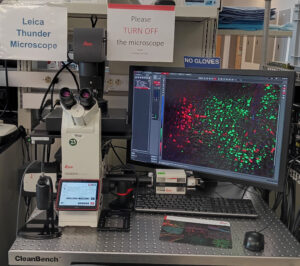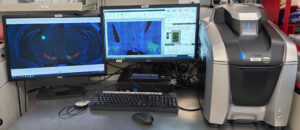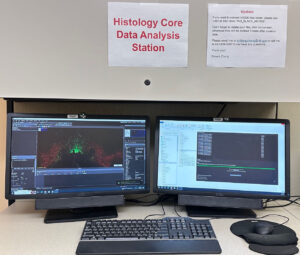Access to equipment
Please request training on how to operate the equipment before scheduling. To schedule equipment use, sign up through the E-Calendar on the NIDA/IRP SCIC homepage (link: https://bis.nida.nih.gov/home/ Requires NIDA IRP Network Access). For rescheduling or cancellations, please email shiliang.zhang@nih.gov.
Olympus VS200 Scanner
Features:
- Olympus VS200 Scanner provides reliable images for quantitative data analysis and improves efficient experimental workflow.
- This system advances the features and makes adaptable for many applications. It can scan standard histology slides and slides labeled with fluorescent indicators.
- This scanner can be used for brightfield, fluorescence, darkfield, phase contrast, and simple polarization. This flexibility allows you to combine different observation methods to view structures that are only visible under certain conditions.
- The objectives include 2x, 4x, 10x, 20x, 40x and 60x oil lens. Autofocus works accurately across large and uneven sample regions at all magnifications.
- It can scan up to 210 slides in a batch. Robotic loader can safely load and upload the sample tray with multiple slides quickly at once.
- The oil dispenser automatically dispenses immersion oil to switch high magnification.
- The flexible batch scan mode enables to designate a different observation method for each slide contained in a batch.
Miltenyi Biotec UltraMicroscope Blaze
Features:
- This pioneering UltraMicroscope technology combined with cutting-edge light sheet optics ensures excellent data quality.
- It is a fully automated light sheet microscope for imaging large or multiple cleared samples at subcellular resolution.
- A standard sample chamber allows convenient imaging of multiple rodent organs or organoids.
- Additionally, the new XXL chamber represents a powerful upgrade, specially designed to provide the largest possible sample space for the UltraMicroscope Blaze. It enables fitting of samples as big as a human kidney or whole adult mouse rat models.
Leica Thunder Microscope
Features:
- The Thunder Microscope has 8 LEDs lamp ideal for multiplexing approaches.
- It allows imaging at 5, 20, 25, 40, 60 and 63x with a software that performs post-processing deconvolution algorithms for computational clearing and enhancing the resolution of nanometer scale structures.
- It has a fully motorized stage and can image in 3-D to acquire tiles for mosaic stitching of large images with a z-stack.
- It allows the resolution to be enhanced.
- THUNDER Imagers with Computational Clearing define a new class of instruments for high-speed, high-quality imaging of thick, 3-dimensional specimens.
Keyence BZ-X720 Microscope
Features:
- It can collect mosaic pictures at Objectives: 2x, 4x, 10x, 20x, 40x, 60x up to 4 fluorophores at a time.
- It can be set to take pictures on up to 3 slides at a time with excellent stitching and good autofocus on fluorescence tissue.
SmartClear Pro II
- SmartClear Pro II (location: 05A314.7)
- SmartLabel (location: 05A314.7)
Features:
- The SmartClear Pro and SmartLabel provide a platform with hydrogel based clearing system.
- The platform is for multiplexing for protein and mRNA.
- It works with control environment.
- It aids clearing and immunostaining with a stochastic electric field.
Olympus MVX10 Microscope
Features:
- The Olympus MVX10 is a dissection-style stereoscopic microscope. It is excellent for taking pictures of injection sites and electrode placement at low magnification.
- 63x and 2x objectives, with secondary adjustment increments from 0.63 to 6.3x.
- Allows for fluorescence detection of up to 3 fluorophores. Detection of Fluorogold, DAPI, DyLight 405, GFP, AlexaFluor488, FITC, tdTomato, mCherry, TRITC, AlexaFluor596, CY5, CY7 and AlexaFluor790 dyes has been validated.
Leica 3050S Cryostats
- Leica 3050S Cryostat-1 (location: 05A314.10)
- Leica 3050S Cryostat-2 (location: 05A314.10)
Features:
- Cryostats is for sectioning in 5-50 µm thickness for samples at low temperature.
Leica Vibratome VS1000T
Features:
- Vibratome is for sectioning in 30-250 µm thickness for samples at room temperature.
- It is designed to consistently produce thin sections of fixed tissue specimens, even non-homogeneous specimens that are difficult to section.
Data Analysis Workstation
- Computer A – Imaris (location: 08A205.10)
- Computer B – VS Export (location: 08A205.07)
Features:
- Histology and Imaging Core has three computers for open use of NIDA IRP researchers.
- Computer A includes software ImageJ, Imaris, Dragonfly.
- Computer B includes software for VS export.
- Computer C is used for MATLAB.












